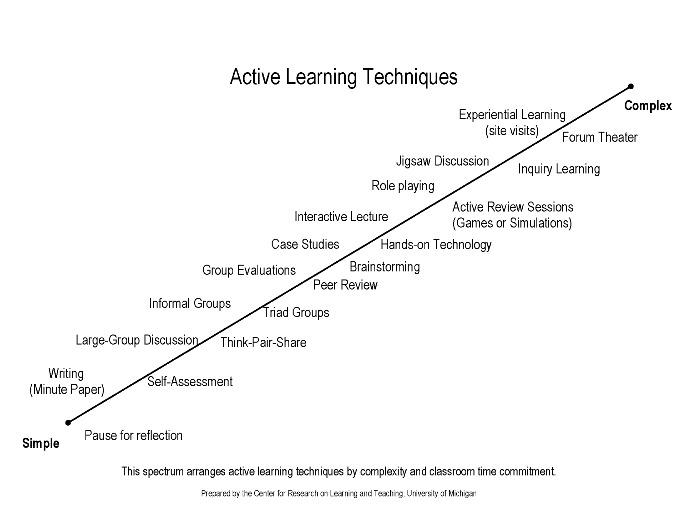Applying active learning as a teacher
Active learning activities are teaching methods that you can use as a teacher to promote active learning in students. Implementing active learning means shifting the focus of instruction from knowledge transfer to student knowledge construction through the creation of guided tasks, interactions, assignments, and environments that cultivate deep, meaningful learning.
Active learning activities promote understanding rather than memorizing facts; they encourage students to apply what they have learned to different problems and contexts (problem-based learning). In addition, students gain more autonomy and ownership in their learning process.
Constructive alignment
When choosing learning activities, it is always important to keep constructive alignment in mind. Do the learning activities match the set learning objectives and the way in which the achievement of these learning objectives will be tested?
Active learning activities
Below are several examples of active learning activities. The list is by no means exhaustive, but it does provide a handy overview to inspire teachers in the design of their course. The image is from the University of Michigan (Introduction to Active Learning). The activities mentioned are also described in detail on this website.

1-2-4-more pyramid
Each person writes brief notes about the topic and then compares them with a partner. Each pair discusses its combined list with another couple. This provides a good basis for discussion in the wider group. It is a good idea to limit the ‘1-2-4’ stages, e.g. 2 minutes or so for each individual and for paired work, 5 minutes for the ‘4’ stage.
Buzz group
Have students discuss a topic or question in smaller groups for a couple of minutes. Afterwards each group can share some of their arguments or questions.
Case study
Provide the students with a real-world case to study in smaller groups and analyze using a guideline of framework provided by you. Afterwards each group can shortly present their findings.
Concept map
Divide students in groups and have them create a concept map of (a part of) the assigned literature. A concept map is a graphic organizer that can be used to organize and represent knowledge about a certain subject. A concept map starts with a main idea/concept which then branches out to show the connection to other elements within this concept.
Debate
Divide the class in half and have each group represent a particular side of a debate. Give students 15 minutes to prepare their argument. The screens can be used by the students to present their arguments. After both sides have presented their arguments, give students 10 minutes to prepare a response. Lastly, give students another 10 minutes to respond to the criticisms of the opposition.
Group text reading
Select a ‘”difficult” text or passage. Break the large text up into 1-2 paragraph sections. Divide students into groups of 2-4. Give each group of students a different section of the text/passage.Give the students time to read through and discuss their section of the text. Bring the class back together. Each group (starting with the first part of the text) presents their section to the class.
Idea line-up
Present a question to the students to which a spectrum of responses is possible. Then ask the students to take a stance on where they stand on the line (literally). When students have taken a stand, ask them to state their reasoning and share their thoughts with the class.
Peer review
In this activity, students provide their peers with feedback on their assignments. This can be done in pairs or in groups.
One- or two-minute pitch
Students present their ideas, outcomes or conclusions briefly (very briefly) to the class. They only get one or two minutes to do so, and there is a limited amount of powerpoint slides (if any).
Round table
Have the class move their desks into a circle so that everyone can see each other. The discussion facilitator poses a question. Each person, in turn around the circle, provides a comment. If a student does not wish to comment, they may “pass.” Repeat for a variety of questions.
Small-group discussion
Divide the class into smaller groups and assign one of the students to be the discussion leader who will lead a 10-minute discussion on the assigned reading for the day. Discussion leaders are encouraged to use the screen or projected images as part of their discussion.
Think, pair, share
Have students individually think about a problem or question. Afterwards have them compare their findings and come up with a joint solution with another student to share with the class.
References and more information
For more information and inspiration on active learning activities, see:
-
Baepler, P., Walker, J. D., Brooks, D. C., Saichaie, K., and Petersen, C. I. (2016). A guide to teaching in the Active Learning Classroom. History, research, and practice. Sterling, Virginia: Stylus Publishing LLC.
-
Queen's University, Canada: Examples of Active Learning Activities. This website contains a handy overview of active learning activities, sorted by individual activities, activities for small groups, and activities for large groups of students.
-
University of Michigan, USA: How can you incorporate active learning into your classroom? A continuum of active learning activities with a detailed description of each activity.
-
Center for Academic Teaching and Learning, Utrecht University: Teaching and Learning Collection. This website contains a collection of different learning activities, including detailed descriptions.
